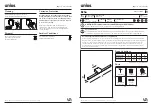
NOTE:
It is our policy to continually improve products and as such we reserve the right to alter data, specifications and component parts without prior notice.
iMPORTAnT:
no liability is accepted for incorrect use of this product.
WARRAnTY:
guarantee is 12 months from purchase date, proof of which will be required for any claim.
01284 757500
01284 703534
Sole uK Distributor, Sealey Group,
Kempson Way, suffolk Business park
,
Bury st. edmunds, suffolk,
Ip32 7Ar
www.sealey.co.uk
4.5.
Battery voltage/charge level
4.5.1. If the load test result indicates a battery fault allow battery to stabilise for a few minutes and then read the open circuit voltage - meter reading
with load switch ‘off’.
4.5.2. compare the reading with the Voltage/charge table above right to get an estimation of the charge level.
4.5.3. the battery is considered charged at 75% or more. If it failed the load test with this charge it should be replaced. If the voltage indicates
a charge level below 75% then charge the battery and load test again. If battery fails this second test replace it.
4.6.
charging system (12 volt)
4.6.1. start engine and allow to reach normal operating temperature. switch off all accessories.
4.6.2. run engine at 1200 to 1500rpm and note meter reading, which should be in the green ‘oK’ sector (fig.1H).
DO nOT press the load switch.
4.6.3. switch on head lights and heater fan (highest speed), meter reading should remain in the green ‘oK’ sector.
4.6.4. A reading in the red sector to the left (fig.1g) indicates a fault in the charging system which will cause the battery to be under charged. A
reading in the red sector to the right (fig.1I) indicates a fault which will cause the battery to be over charged.
note:
Although not marked on the meter scale the ‘oK’ range for a 6 volt charging system is 6.8 to 7.5 volts.
4.7.
Starter motor (12 volt)
note:
this test requires that the battery is in good condition and is charged to at least 75% capacity.
4.7.1. disable ignition system; remove the fuse or similar so that engine will not start.
4.7.2. carry out a load test (section 3.3.), if not already done and note voltage reading.
4.7.3. use the table given below or fig.1J. to determine the equivalent minimum cranking voltage. note that for engines of less than 3.25 litres
take the next higher figure. For example:- a) 3.5 litre engine - load test result 11.0 volts, gives min. cranking voltage of 9.7 volts.
b) 1.5 litre engine - load test result 11.0 volts, gives min. cranking voltage of 10.2 volts
table:-
load
voltage
10.2 10.4 10.6 10.8 11.0 11.2 11.4
min. cranking voltage 7.7
8.2
8.7
9.2
9.7
10.2
10.6
4.7.4. operate the starter motor and note the voltage during cranking.
4.7.5. A reading below the minimum cranking voltage indicates that the starter motor is taking excessive current. this may be due to poor
connections, to a faulty motor or to the battery being too small for vehicle.
4.7.6. After test reinstate ignition system.
note:
For a 6 volt system test as above and note load test voltage. double this value and determine equivalent minimum cranking voltage as in
stage 4.7.3.. Halve the figure to give minimum cranking voltage for the 6 volt system and then proceed from stage 4.7.4..
Open circuit Voltage
charge %
12 volt/6 volt battery
11.7/5.8 or lower
0
12.0/6.0 25
12.2/6.1 50
12.4/6.2 75
12.6/6.3 or higher
100
Load Test Result
Battery condition
OK-Green (fig.1F - 12V)
(fig.1B - 6V)
Battery capacity is good. May or may not be fully charged. Check electrolyte specific gravity to determine
charge state. If not fully charged, check for charging system fault (section 4.6) or electrical drain.
Weak or Bad -yellow or red, but
pointer reading steady.
(fig.1D/E - 12V)
(fig.1A/C - 6V)
Battery capacity is unsatisfactory. Battery may be either:- (1) defective or (2) partly discharged.
Check electrolyte specific gravity. If over 1.225, the battery is defective. If under 1.225, recharge the
battery and retest. If cell to cell specific gravity varies by more than 0.025 a cell defect may exist. If
charging does not bring specific gravity to full charge level, the battery is either sulphated or has lost
active material.
Weak or Bad - yellow or red, but
pointer reading falling after 10
seconds on load.
Battery may be defective. release load switch and note the meter reaction. If the voltage recovers to 12
volts (6 volts for a 6 volt battery) or more in a few seconds, then the battery is probably defective. If the
voltage recovers slowly the battery may only be discharged. Check the electrolyte specific gravity and
proceed as above
4.4.
Load test chart
Environmental Protection
Recycle unwanted materials instead of disposing of them as waste. All tools, accessories and packaging should be
sorted, taken to a recycling centre and disposed of in a manner which is compatible with the environment.
When the product becomes completely unserviceable and requires disposal, drain off any fluids (if applicable)
into approved containers and dispose of the product and the fluids according to local regulations.
WEEE Regulations
Dispose of this product at the end of its working life in compliance with the Eu Directive on
Waste Electrical and Electronic Equipment (WEEE). When the product is no longer required, it must be disposed
of in an environmentally protective way. contact your local solid waste authority for recycling information.
Bt91/7.V3 Issue: 3(l) - 29/02/16
Original Language Version
© Jack sealey limited





















